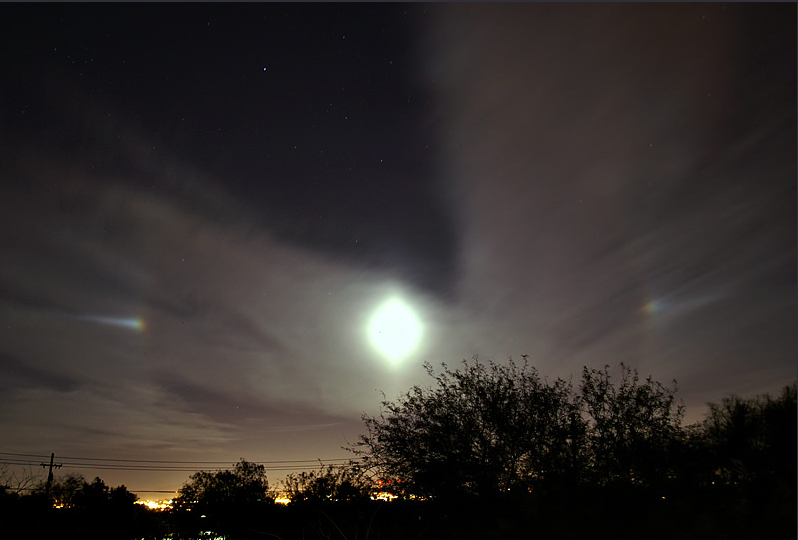Moon Dogs ~Paraselenae
Moon Dogs: An Extraordinary Atmospheric Phenomenon
Moon dogs, also known as paraselenae, are a captivating atmospheric optical phenomenon that occurs when ice crystals in high cirrus clouds create halos around the moon. While these celestial displays are often associated with cold climates and diamond dust, they can actually be observed anywhere on Earth, during both summer and winter.
When the conditions are just right, moon dogs can transform the night sky into a mesmerizing spectacle. The phenomenon gets its name from the appearance of two bright spots of light on either side of the moon, resembling loyal canine companions. These "dogs" are caused by the refraction and reflection of moonlight through hexagonal ice crystals suspended in the atmosphere.
The formation of moon dogs begins with the presence of cirrus clouds, which are thin and wispy clouds found at high altitudes. These clouds contain an abundance of ice crystals that act as miniature prisms, bending and dispersing light in fascinating ways. As the moonlight passes through these ice crystals, it undergoes refraction and separates into its constituent colors, much like a prism does with sunlight.
The result is a stunning display of colors surrounding the moon. The primary halo is often visible as a faint circle around the moon, caused by the refraction of light at a specific angle. Additionally, the ice crystals can create a parhelic circle, which appears as a horizontal band of light passing through the moon. This band is sometimes accompanied by the moon dogs, appearing as bright spots of light on either side of the moon.
Moon dogs are not limited to a specific location or time of year. Unlike other atmospheric phenomena that require specific weather conditions or geographical factors, moon dogs can be observed anywhere on Earth where cirrus clouds are present. Whether you find yourself in a desert or a snowy landscape, if there are high-level clouds, there is a chance to witness this extraordinary event.
It's important to note that moon dogs are not exclusive to diamond dust, a type of ice crystal that forms near the ground in extremely cold temperatures. While diamond dust can enhance the intensity of moon dogs, they can still occur without it. This means that even in regions with milder climates, the ethereal beauty of moon dogs can grace the night sky.
To capture the magic of moon dogs in photographs, photographers often employ long exposures and low ISO settings to capture the faint light and intricate details. Each image is a unique testament to the wonders of our atmosphere and the captivating phenomena it produces.
In conclusion, moon dogs, or paraselenae, are a captivating atmospheric phenomenon that occurs when ice crystals in high cirrus clouds create halos around the moon. These ethereal displays can be observed anywhere on Earth, during both summer and winter, and are not limited to regions with diamond dust. The next time you find yourself gazing at the night sky, keep an eye out for these celestial companions that add a touch of magic to our world.

Moondogs ~ Paraselenae
Imaged by Steve West(Steve's Atmospheric Phenomena) on Feb 23rd in Tucson, Arizona.
"There was just the weak halo until this wedge-shaped clearing pushed in above the moon. Then the two dogs (and a bit of the parhelic circle) lit up for about 10 minutes. Shot at ISO 200 for 30sec with a Konica Minolta 7D and Sony 11-18 lens. No diamond dust here in the desert though!"
A bright moon makes halos and luckily we do not always need diamond dust. Halos formed by ice crystals in high cirrus clouds can be seen anywhere on Earth summer and winter.
Image ©Steve West, shown with permission.
Note: this article has been automatically converted from the old site and may not appear as intended. You can find the original article here.
Reference Atmospheric Optics
If you use any of the definitions, information, or data presented on Atmospheric Optics, please copy the link or reference below to properly credit us as the reference source. Thank you!
-
<a href="https://atoptics.co.uk/blog/moon-dogs-paraselenae/">Moon Dogs ~Paraselenae</a>
-
"Moon Dogs ~Paraselenae". Atmospheric Optics. Accessed on November 26, 2024. https://atoptics.co.uk/blog/moon-dogs-paraselenae/.
-
"Moon Dogs ~Paraselenae". Atmospheric Optics, https://atoptics.co.uk/blog/moon-dogs-paraselenae/. Accessed 26 November, 2024
-
Moon Dogs ~Paraselenae. Atmospheric Optics. Retrieved from https://atoptics.co.uk/blog/moon-dogs-paraselenae/.